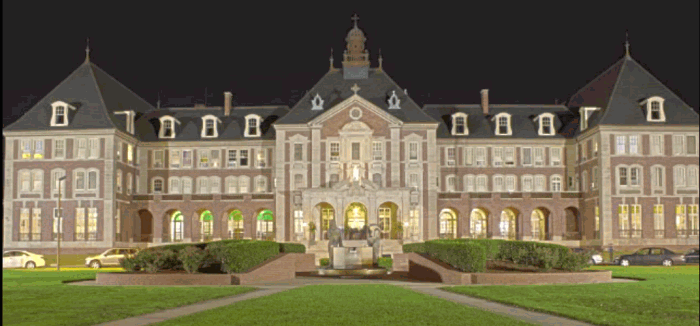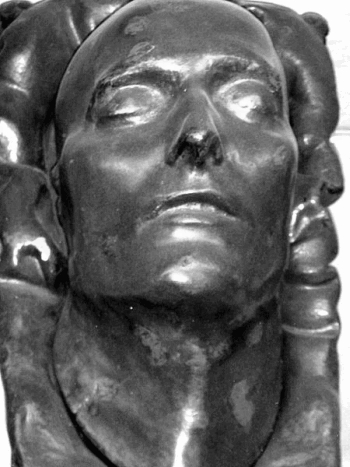The Beginning of the Seminary
February
8. 1922
 Photo from Notre Dame Seminary
Photo from Notre Dame Seminary
Ground was broken for for
the Notre Dame Seminary on Carrollton Avenue on
February 8, 1922. For its history see
http://nds.edu/history/.
You Can Support this Site by Clicking on & Shopping from this Amazon Link -- and it
won't cost you a penny more:


Carnival Day was celebrated on February 8, 2005,
John Norris Teunisson was born in Pike County, Mississippi on January 20, 1869.
He came to New Orleans 1892 and worked initially as an inspector for the Underwriters Inspection Bureau. The New Orleans
city directories do not list him as a photographer until 1901, and the 1900 census gives his profession as "insurance
inspector." In 1893, he married Mary Ellen Frost (his marriage announcement states that he was from Summit, Mississippi);
the couple had four children, one of whom, Nellie May Teunisson, served for a time as her father's photographic assistant.
Once established, Teunisson had a long career as a photographer in New Orleans. His photographs were widely reproduced during
his lifetime in tourist guides to New Orleans, in newspapers, and as postcards. In the 1950s, Teunisson moved to Washington,
D.C., where he died on February 8, 1959, at the age of 90. He is buried in Metairie Cemetery. (NOPL)
View the New Orleans Public Library's collection of Teunisson photos.
On February 8, 1853, the city ordain that the square formerly known as Congo Square later changed to
Place de Armes and located between Rampart, St. Claude, St. Peter and St. Ann Streets, be donated to the State of Louisiana
upon condition that the State Capitol be built thereon. (NOPL)
Kate O'Flaherty Chopin, author. Born, St. Louis, Mo., February 8, 1851; daughter of
Thomas O'Flaherty and Eliza Faris. Christened Katherine O'Flaherty. Father Irish and mother of old St. Louis French background.
Education: Sacred Heart Academy, graduated 1868. Married Oscar Chopin of Louisiana, June, 1870. Removed to New Orleans
where Chopin was a cotton factor. At the end of 1879 removed to Cloutierville on the Red River near Natchitoches. Children:
five sons, born in New Orleans, St. Louis and Cloutierville, and one daughter, born at Cloutierville. After husband's death
in January, 1883, managed affairs of family plantations and general store for several years before removing to St. Louis.
From 1889 to 1902 wrote numerous short stories for children and adults published in magazines such as the Atlantic Monthly,
Vogue, the Century and Harper's Youth's Companion. Her major works: two short story collections, Bayou Folk (1894), and
A Night in Acadie (1897), both contained many stories which had been published in magazines earlier. Two novels: At Fault
(1890), and The Awakening (1899). The people in the stories are almost all inhabitants of French Louisiana and most locales
are in the Natchitoches area. Grand Isle and New Orleans are the locations for the Awakening. Best known short story,
"Desirée's Baby", a tale of miscegenation in antebellum Louisiana. She wrote of Louisiana women in the
nineteenth century, but she addressed concerns of women in all places and times. Died, St. Louis, of a brain hemmorrhage,
August 22, 1904. Source: http://lahistory.org/site20.php
On February 8, 1800, an extraordinary
session was called by the Governor and President, in accord with the Commissioners, ordered Jose Antonio Boniquet and Bernardo
Coquet to present themselves in these chambers in order to reprimand and admonish them. The Governor stated that Boniquet
and Coquet are partners and had obtained a permit for a dancing hall - one for white and one for colored - from the late
Governor Gayoso; also a permit in favor of Boniquet for the lottery. He mentions the restrictions imposed and the abuses
which had crept in, but resolved not to prohibit the dancing hall nor the lottery so that the people could not say it was
a pretext to obstruct the operation of the play house, as without this income the performances could not continue.
On February 8, 1779, Governor Galvez called the Cabildo into extraordinary session to consider the epidemic
of small pox, and having been advised of its prevalence along the river front, he has taken steps to isolate those afflicted
to the other side of the river, notwithstanding the heavy expense to the Royal Treasury, providing excellent care and permitting
parents to accompany their children. His Excellency suggested the calling of an assembly of prominent people and parents
of the city to meet in this chamber with the Cabildo to determine measures to be taken, and if accepted, enforced. The
Commissioners agreed to this, and also voted to implore the Governor to continue the care and attention of those afflicted
with the disease. (NOPL)
Spain was at war with England during 1797 and evidence of that conflict is reflected
in the entries for January 31 and February 8, both of which list English vessels that had been captured by
French corsairs. Note also that on February 8 the schooner Amistad was at New Orleans--this was not the same vessel that was
made famous by the 1839 slave insurrection. (NOPL)
Napoleon's Death Mask Back in New Orleans
February 8, 1909
On May
5, 1821, on the Isle of St. Helena, Emperor Napoleon Bonaparte lay on his death bed. At his side was Dr. Francesco Antommarchi,
the man who shared his exile, as well as being a friend and personal physician. When Napoleon took his last breath, it was
Dr. Antommarchi who pronounced him dead and closed his eyes for the last time. To preserve the moment for all eternity,
Dr. Antommarchi made plans to construct a mold for a death mask. Plaster necessary to make the mold was not immediately
available because of a severe storm.

It was 40 hours after Napoleon’s death that proper materials were available. This unfortunate incident, along with
Napoleon’s lingering and painful death, were the main reasons for the death mask looking more like Caesar than the
Emperor Napoleon.
In 1824, Dr. Antommarchi reached France with his cherished mold. He was able to obtain a royal
mandate to the French mint to make three bronze castings of Napoleon’s death mask. The first of the three to be cast
was brought to New Orleans by Dr. Antommarchi in November of 1834; the other two were placed in a museum and a hotel in
Paris.
The good doctor was received by the people of New Orleans with great enthusiasm. He was profoundly impressed
by the generous sentiments of the populace, and he was moved to the point of donating the original casting of Napoleon’s
death mask to the City of New Orleans.
After a fitting parade, the mask was put display in the illustrious Cabildo.
It was appropriately placed in the same room where Louisiana, through Napoleon’s maneuvering, was transferred to the
United States in 1803.
The mask of the dead exiled emperor remained at the Cabildo until 1852 when it was moved
to the newly constructed City Hall on St. Charles Street – now Gallier Hall.
The war between the states
brought destruction as well as confusion. In 1866, after the war had ended, Mr. Adam Griffin of New Orleans, while walking
on Canal Street, saw the Napoleon death mask being carried away in a junk wagon. He purchased the mask from the junk dealer,
took it home and displayed it on his library table. Upon his death in 1890, it was given to Mrs. Robert Griffin, the widow
of his son. She sold it to Captain William G. Raoul, president of the Mexican National Railroad, who brought it to his home
in Atlanta.
When New Orleans city officials finally found out where the mask was, they contacted Captain Raoul,
who generously agreed to sell it back to the city of New Orleans for the price he paid plus interest. His only other request
was that a fitting inscription of his act be placed beside the relic. Mayor Martin Behrman agreed to his terms, and the
mask was returned to New Orleans on
February 8, 1909. It was once again placed in the Cabildo after a 57-year
absence.
From Cabildo to City Hall to who knows where before being put on a junk wagon, to two private homes,
and then back to the Cabildo, where it survived the 1988 fire, the death mask of Emperor Napoleon, like the man himself,
is well traveled, controversial and has remained very much in the news.
By Buddy Stall. Source: Buddy
Stall at http://clarionherald.org/20010802/stall.htm Photo by heurtelions.








 It was 40 hours after Napoleon’s death that proper materials were available. This unfortunate incident, along with
Napoleon’s lingering and painful death, were the main reasons for the death mask looking more like Caesar than the
Emperor Napoleon.
It was 40 hours after Napoleon’s death that proper materials were available. This unfortunate incident, along with
Napoleon’s lingering and painful death, were the main reasons for the death mask looking more like Caesar than the
Emperor Napoleon. 
